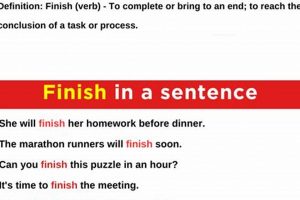A Finishing Move in Call of Duty is a special melee attack animation performed when an enemy player is unaware of the attacking player’s presence. This action results in an instant elimination of the targeted opponent. To execute this, the player must approach an enemy from behind and press the designated melee attack button. The exact button may vary depending on the platform and the player’s custom control configuration.
The inclusion of Finishing Moves adds a layer of strategic depth and cinematic flair to gameplay. Successfully executing one not only provides a swift and silent takedown but also grants the player a brief moment of visual spectacle. This can be particularly advantageous in stealth-oriented playstyles or when attempting to conserve ammunition. Historically, such maneuvers evolved from simple melee attacks to elaborate animations, offering players customization options and unique expressions of skill.
The following sections will detail the specific control inputs required on different platforms, strategies for successfully positioning oneself to perform these actions, and common pitfalls to avoid when attempting a Finishing Move during a match.
Executing Finishing Moves
Successful execution of Finishing Moves requires a combination of stealth, timing, and awareness. The following tips provide guidance on improving the frequency and effectiveness of these maneuvers.
Tip 1: Utilize Tactical Equipment. Employ flashbangs, stun grenades, or smoke grenades to disorient enemies, creating opportunities to approach undetected.
Tip 2: Exploit Audio Cues. Pay close attention to enemy footsteps and gunfire to identify vulnerable targets who are preoccupied with other engagements.
Tip 3: Master Map Knowledge. Learn common patrol routes and flanking positions to anticipate enemy movements and intercept them from behind.
Tip 4: Prioritize Stealth Perks. Equip perks that reduce footstep sound and increase crouch movement speed to minimize the risk of detection.
Tip 5: Practice Proper Positioning. Ensure the player is directly behind the target before initiating the Finishing Move to avoid triggering a standard melee attack instead.
Tip 6: Observe Enemy Behavior. Identify players who tend to focus on specific areas or objectives, making them easier to predict and flank.
Tip 7: Be Patient. Do not rush the approach. A failed attempt can alert the enemy and expose the player to significant risk.
By implementing these strategies, players can significantly enhance their ability to perform Finishing Moves, gaining a tactical advantage and adding a stylish element to their gameplay.
The subsequent section will address common errors and misconceptions related to this technique, offering further clarification for optimal execution.
1. Stealth Approach
The success of a Finishing Move in Call of Duty is inextricably linked to the player’s ability to execute a silent and undetected approach. The element of surprise is paramount. If the target is alerted to the player’s presence before the melee button is pressed, the opportunity for a Finishing Move is typically lost, resulting in a standard melee attack or, more likely, an unfavorable firefight. A Stealth Approach, therefore, functions as a pre-requisite for the desired outcome. For instance, a player attempting to traverse an open area without cover, even if perfectly aligned behind an enemy, is unlikely to successfully initiate a Finishing Move due to the high probability of visual or auditory detection.
Various in-game mechanics directly support the execution of a Stealth Approach. Perks such as “Ghost” or “Cold-Blooded” can conceal the player from enemy radar and reduce the effectiveness of thermal optics. Similarly, equipment like suppressors on weapons minimizes noise, preventing the enemy from hearing the player’s approach. Utilizing these tools in conjunction with careful navigation allows players to bypass enemy lines and position themselves for a silent takedown. A practical example would be using the “Dead Silence” perk to temporarily eliminate footstep sounds while flanking an enemy camping in a building.
In conclusion, the Stealth Approach is not merely a contributing factor to the Finishing Move; it is a fundamental requirement. While skillful aim and quick reflexes are valuable assets in Call of Duty, the ability to move undetected and exploit moments of enemy vulnerability unlocks access to Finishing Moves, providing a tactical advantage and an instant elimination. Mastering the art of stealth, therefore, significantly enhances a player’s capacity to execute these decisive actions.
2. Melee Button Input
The correct Melee Button Input is critical for initiating a Finishing Move sequence in Call of Duty. It serves as the direct trigger that differentiates a standard melee attack from the specialized animation of a Finishing Move. Without the accurate and timely execution of this input, the maneuver will not be performed.
- Button Configuration
The specific button assigned to melee attacks varies by platform and custom control schemes. On consoles (PlayStation, Xbox), default assignments typically involve the right analog stick button (R3/RS). On PC, the default is often the “V” key. Players may reconfigure these settings. It’s essential to know the currently assigned button for a successful Finishing Move attempt.
- Contextual Sensitivity
The Melee Button Input operates with contextual sensitivity. If the player is directly behind an unsuspecting enemy and within the required range, pressing the assigned melee button triggers the Finishing Move animation. Conversely, pressing the same button when facing an enemy or outside the specified range will execute a standard melee attack, which is often less effective and potentially dangerous.
- Timing Precision
While the input itself is straightforward, timing is crucial. Pressing the melee button too early or too late might result in a regular melee strike. The game registers the proximity and angle to the target within a short window. Therefore, accuracy in the approach must be coupled with precise timing of the button press to initiate the intended animation sequence.
- Input Conflicts
Potential input conflicts can arise due to button mapping overlaps. If the assigned melee button also serves another function (e.g., tactical sprint activation), unintended actions can occur. Minimizing button overlaps or adjusting sensitivity settings can help prevent misfires during critical moments.
In conclusion, the Melee Button Input, though seemingly simple, is a pivotal element. Its proper configuration, contextual awareness, timing, and mitigation of potential conflicts all contribute to the successful execution of a Finishing Move. Mastering this input is essential for players aiming to integrate this silent takedown technique into their Call of Duty gameplay.
3. Precise Positioning
Precise Positioning is a non-negotiable prerequisite for a successful Finishing Move in Call of Duty. The game’s mechanics are designed such that the Finishing Move animation only triggers when the attacking player is located within a specific, narrow zone directly behind the target. Deviation from this position results in a standard melee attack, negating the intended silent takedown. The effect of improper positioning can be observed when a player, attempting a Finishing Move from a slightly angled position, initiates a standard knife slash instead. The target is alerted, and the attacker is placed at a tactical disadvantage. Precise Positioning is, therefore, a causative factor for a successful execution of the specified maneuver.
The significance of Precise Positioning extends beyond the mere triggering of the animation. It ensures that the player’s actions align with the intended outcome: a swift and silent elimination. The practical application of this understanding is evident in high-stakes gameplay scenarios, such as Search and Destroy, where a single mistake can cost the round. A player who meticulously approaches an enemy from directly behind, adhering to the Positioning requirements, secures a guaranteed kill and potentially shifts the balance of the match. This is different from a rushed or poorly executed attempt, which frequently leads to detection, a missed opportunity, and a potentially fatal counter-attack. Understanding the precise angle and range to initiate this action is, thus, strategically vital.
In summary, Precise Positioning is not merely a desirable element but a fundamental component of Finishing Moves in Call of Duty. Its mastery provides players with a reliable method for silent takedowns and a crucial advantage in tactical situations. The challenges of achieving the required Positioning are mitigated by awareness, practice, and the strategic use of in-game tools and perks. Failure to prioritize Precise Positioning consistently undermines the effectiveness of Finishing Moves, reinforcing its central role in the overall execution.
4. Target Awareness
Target awareness is inversely proportional to the successful execution of a Finishing Move in Call of Duty. A target exhibiting a high level of situational awareness is less susceptible to a Finishing Move attempt. Conversely, a target exhibiting limited awareness presents an opportune environment for initiating and completing the silent takedown. The execution of the described maneuver is predicated on the element of surprise, which is directly undermined by the targets vigilance. If the targeted player is actively scanning their surroundings, listening for audio cues, and monitoring their radar, the likelihood of a successful, undetected approach is significantly diminished.
The practical application of this understanding is evident in various gameplay scenarios. For example, a player fixated on a sniper scope is significantly more vulnerable to a Finishing Move than a player actively rotating and checking flanks. Similarly, a player engrossed in a close-quarters firefight is less likely to detect a stealthy approach. Identifying these moments of vulnerability is crucial for capitalizing on Finishing Move opportunities. Effective use of tactical equipment such as flashbangs or stun grenades can further reduce target awareness, creating windows for undetected approaches. A player attempting to initiate a Finishing Move on an opponent actively using a UAV and diligently watching the minimap faces a far greater challenge than one targeting a player distracted by an objective.
In summary, target awareness functions as a critical variable influencing the success rate of Finishing Moves in Call of Duty. Recognizing and exploiting moments of reduced awareness is essential for effectively integrating this silent takedown tactic into one’s gameplay strategy. The challenges inherent in approaching and eliminating a highly aware target underscore the importance of selecting opportune moments and employing tactical advantages to minimize risk and maximize the chances of a successful Finishing Move execution.
5. Animation Trigger
The Animation Trigger represents the precise event that initiates the unique sequence associated with a Finishing Move in Call of Duty. It is the culmination of several preceding conditions, the most crucial being the proximity and position of the attacker relative to an unsuspecting target. Understanding the nuances of this Animation Trigger is paramount for consistently and reliably executing Finishing Moves.
- Proximity and Angle
The game engine constantly evaluates the distance and angular relationship between the player character and nearby entities. A Finishing Move Animation Trigger is contingent upon the attacking player being located within a narrowly defined cone directly behind the target. Deviation from this spatial criterion typically results in a standard melee attack rather than the intended cinematic sequence. The precise angle and distance vary based on the game title but always require close-quarters positioning.
- Target State Evaluation
The game also evaluates the state of the targeted player. A Finishing Move Animation Trigger will typically only occur if the target is unaware or otherwise vulnerable. This assessment may involve monitoring player input (e.g., lack of recent directional changes or weapon aiming), audible cues (e.g., absence of footstep sounds), or visual indicators (e.g., focus on a specific objective). If the target is actively engaged in combat or demonstrating heightened awareness, the Animation Trigger is suppressed.
- Input Priority and Override
The Melee Button Input acts as a potential Animation Trigger. However, it’s subject to priority rules and overrides. If the Melee Button Input is received while the player is sprinting, sliding, or performing another action, the Finishing Move is often superseded by the dominant action. The Animation Trigger prioritizes the action initiated first, meaning that the player must cease movement and complete necessary conditions to execute a finishing move.
- Animation Interruption
The Animation Trigger does not guarantee the completion of the Finishing Move sequence. External factors can interrupt the animation, negating its effect. If the attacker is damaged during the animation, the sequence may be aborted. Similarly, if the target moves out of the required zone during the animation, the sequence may terminate prematurely. This vulnerability highlights the need for careful timing and situational awareness, even after the Animation Trigger has occurred.
The elements contributing to the Animation Trigger are interconnected and dynamic. Successfully performing Finishing Moves necessitates a comprehensive understanding of these interdependencies. By mastering the conditions and mitigating the potential for interruption, players can reliably access the strategic and visual advantages afforded by Finishing Moves in Call of Duty.
6. Situational Timing
Situational Timing functions as a critical determinant in the successful execution of a Finishing Move in Call of Duty. The precise moment chosen to initiate the maneuver significantly impacts the outcome, distinguishing a successful, silent elimination from a failed attempt and potential exposure. An assessment of the immediate environment and the target’s actions are central to effective execution. Examples include initiating the move when a player is reloading, mounting a turret, or focused on a distant objective, making them temporarily vulnerable. Poor timing, such as attempting the move when an enemy is actively engaged in a firefight or demonstrably aware of their surroundings, typically results in failure. Proper situational timing acts as a mediating factor, connecting the player’s intention with the desired result, and serves as a precondition for an efficient finishing move.
The consideration of situational timing also encompasses external factors that can impact the process. The presence of teammates or enemy combatants in the immediate vicinity introduces a high degree of risk. Initiating a Finishing Move within earshot of another enemy exposes the player to potential interruption and elimination. Conversely, coordinating with teammates to create distractions or draw enemy fire provides opportune moments for silent takedowns. An example could be having a teammate provide covering fire, creating a distraction which would allow for the quiet execution of an unsuspecting opponent. The ability to accurately assess these dynamic variables represents a mastery of the game’s mechanics and underscores the strategic depth associated with the Finishing Move.
In summation, situational timing serves as a linchpin connecting player awareness, tactical decision-making, and effective Finishing Move execution. Recognizing and capitalizing on moments of enemy vulnerability is paramount, though it presents constant challenges. Mastering the element of timing elevates this particular action from a high-risk gamble to a calculated maneuver, thereby adding a subtle edge to the overall combat proficiency.
Frequently Asked Questions
This section addresses commonly encountered queries and misconceptions regarding the execution of Finishing Moves in Call of Duty. The information provided aims to clarify the mechanics and enhance the player’s understanding of this tactical maneuver.
Question 1: What precisely constitutes a “Finishing Move” in Call of Duty?
A Finishing Move is a distinct melee attack animation triggered when the attacking player approaches an unsuspecting enemy from behind and presses the designated melee button. This results in an immediate elimination, accompanied by a unique, character-specific animation.
Question 2: Is a Finishing Move guaranteed to succeed if the melee button is pressed behind an enemy?
No, specific conditions must be met. Proximity, precise positioning directly behind the target, and the target’s lack of awareness are crucial. If any of these conditions are not met, a standard melee attack will be executed instead.
Question 3: How can stealth be improved to facilitate Finishing Moves?
Employing perks that reduce footstep sound and increase crouch movement speed is recommended. Tactical equipment such as flashbangs and smoke grenades can also disorient enemies, creating opportunities for undetected approaches.
Question 4: Can a Finishing Move be interrupted once initiated?
Yes, Finishing Moves are vulnerable to interruption. If the attacking player sustains damage during the animation or if the target moves out of the required proximity zone, the sequence may be aborted.
Question 5: Does the button input for Finishing Moves differ across platforms?
The default button mapping may vary by platform (PlayStation, Xbox, PC). Players also have the option to customize control schemes, so verification of the assigned melee button is essential.
Question 6: Are all characters in Call of Duty equipped with unique Finishing Move animations?
The availability and style of Finishing Move animations may vary depending on the specific character skin or operator selected. Certain cosmetic items may unlock unique or alternate Finishing Move sequences.
Mastering Finishing Moves in Call of Duty involves more than simply approaching an enemy from behind. A strategic combination of stealth, timing, and situational awareness is crucial for successful execution. This FAQ section offers guidance for improving overall technique and understanding of in-game mechanics.
The next section will provide closing thoughts regarding the overall strategy.
Conclusion
The preceding discussion clarifies aspects surrounding how to do a finishing move in Call of Duty, focusing on fundamental mechanics such as positioning, timing, and target awareness. It emphasizes that successful execution is not merely a matter of proximity, but rather the confluence of various factors. These range from the element of surprise to the precise initiation of an animation sequence. Practical guidance, including tactical equipment and stealth enhancements, underlines the methods reliance on strategic maneuvering.
Achieving mastery of this technique requires persistent practice and a deep understanding of in-game dynamics. As gameplay evolves, adapting execution strategies will become essential. The ability to consistently perform Finishing Moves represents an advanced level of skill, offering a tactical advantage and serving as a testament to overall expertise. Therefore, continued refinement of these skills is highly recommended to sustain competitiveness in a dynamic combat environment.







